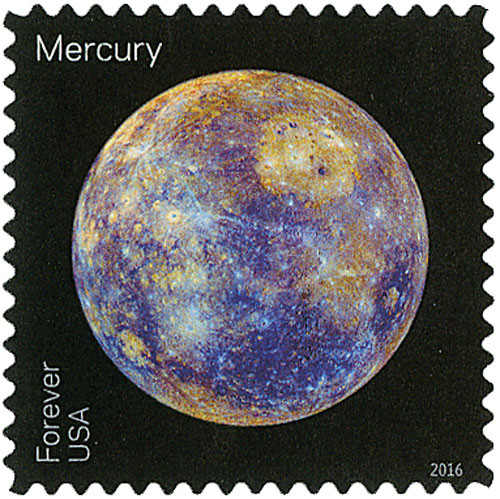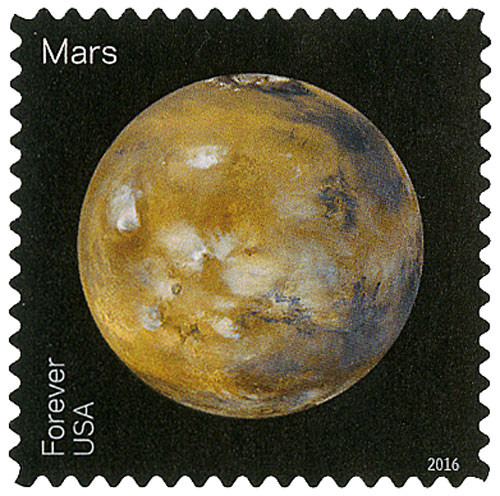
# 5073 - 2016 First-Class Forever Stamp - Views of Our Planets: Jupiter
US #5073
2016 Jupiter – Views of Our Planets
- Pictures Jupiter, the fifth planet from the Sun
- One of 8 stamps issued alongside the 2016 Pluto Explored stamps to commemorate space exploration in our Solar System and New Horizon spacecraft’s flyby of Pluton in 2015
Stamp Category: Commemorative
Set: Views of Our Planets
Value: 47¢ First Class Mail Rate (Forever)
First Day of Issue: May 31, 2016
First Day City: New York, New York
Quantity Issued: 40,000,000
Printed by: Ashton Potter (USA) Ltd.
Printing Method: Offset
Format: Panes of 16
Tagging: Nonphosphored type III, spot tag
Why the stamp was issued: To showcase Jupiter, the fifth planet from the Sun, and the NASA efforts that have allowed us to see this planet up-close. To honor NASA’s space exploration efforts within our Solar System that have given us up-close images of every plant and – as of 2015 – dwarf planet Pluto.
About the stamp designs: Pictures an image of Jupiter from NASA, the European Space Agency, and E. Karkoschka (Arizona Board of Regents, University of Arizona).
First Day City: The First Day of Issue Ceremony was held at the Javits Center in New York City during the World Stamp Show 2016.
About the Views of Our Planets set: Eight stamps issued to honor NASA’s space exploration efforts within our Solar System that have given us up-close images of every planet and – as of 2015 – dwarf planet Pluto. Each stamp pictures one planet in our Solar System. According to the USPS, “Some show the planet’s ‘true’ color – what we might see with our own eyes if traveling through space. Others use colors to represent and visualize certain features of a planet based on imaging data. Still others use the near-infrared spectrum to show things that cannot be seen by the human eye in visible light.”
History the stamp represents: Our solar system’s largest and most massive planet, Jupiter, is fittingly named after the Roman king of the Gods.
Jupiter contains more than twice the mass of all the other planets in our solar system combined. Known as a “gas giant,” it is composed of material left over from the formation of the Sun. These gases take the form of color bands of clouds and spots made up of ammonia and a number of unknown chemicals. Because Jupiter completes one rotation quickly – in just 10 hours – jet streams form, creating bands of clouds across the planet.
Jupiter may be most famous for its Great Red Spot, a swirling storm of 400-mile-per-hour winds that is twice as wide as Earth. Impact sites from comets create Jupiter’s other spots. Because there appears to be no solid surface to slow them, these spots can remain for hundreds of years.
Blow an atmosphere of hydrogen and helium, hydrogen gas is compressed into liquid, creating the solar system’s largest ocean. Scientists speculate there may be a solid core below that.
While Jupiter is uninhabitable, Europa, one of its more than 60 moons, may be. It is home to a large frozen ocean. And scientists believe there may be a liquid-water ocean with the ingredients for life below the crust, making it a popular choice for future missions.
US #5073
2016 Jupiter – Views of Our Planets
- Pictures Jupiter, the fifth planet from the Sun
- One of 8 stamps issued alongside the 2016 Pluto Explored stamps to commemorate space exploration in our Solar System and New Horizon spacecraft’s flyby of Pluton in 2015
Stamp Category: Commemorative
Set: Views of Our Planets
Value: 47¢ First Class Mail Rate (Forever)
First Day of Issue: May 31, 2016
First Day City: New York, New York
Quantity Issued: 40,000,000
Printed by: Ashton Potter (USA) Ltd.
Printing Method: Offset
Format: Panes of 16
Tagging: Nonphosphored type III, spot tag
Why the stamp was issued: To showcase Jupiter, the fifth planet from the Sun, and the NASA efforts that have allowed us to see this planet up-close. To honor NASA’s space exploration efforts within our Solar System that have given us up-close images of every plant and – as of 2015 – dwarf planet Pluto.
About the stamp designs: Pictures an image of Jupiter from NASA, the European Space Agency, and E. Karkoschka (Arizona Board of Regents, University of Arizona).
First Day City: The First Day of Issue Ceremony was held at the Javits Center in New York City during the World Stamp Show 2016.
About the Views of Our Planets set: Eight stamps issued to honor NASA’s space exploration efforts within our Solar System that have given us up-close images of every planet and – as of 2015 – dwarf planet Pluto. Each stamp pictures one planet in our Solar System. According to the USPS, “Some show the planet’s ‘true’ color – what we might see with our own eyes if traveling through space. Others use colors to represent and visualize certain features of a planet based on imaging data. Still others use the near-infrared spectrum to show things that cannot be seen by the human eye in visible light.”
History the stamp represents: Our solar system’s largest and most massive planet, Jupiter, is fittingly named after the Roman king of the Gods.
Jupiter contains more than twice the mass of all the other planets in our solar system combined. Known as a “gas giant,” it is composed of material left over from the formation of the Sun. These gases take the form of color bands of clouds and spots made up of ammonia and a number of unknown chemicals. Because Jupiter completes one rotation quickly – in just 10 hours – jet streams form, creating bands of clouds across the planet.
Jupiter may be most famous for its Great Red Spot, a swirling storm of 400-mile-per-hour winds that is twice as wide as Earth. Impact sites from comets create Jupiter’s other spots. Because there appears to be no solid surface to slow them, these spots can remain for hundreds of years.
Blow an atmosphere of hydrogen and helium, hydrogen gas is compressed into liquid, creating the solar system’s largest ocean. Scientists speculate there may be a solid core below that.
While Jupiter is uninhabitable, Europa, one of its more than 60 moons, may be. It is home to a large frozen ocean. And scientists believe there may be a liquid-water ocean with the ingredients for life below the crust, making it a popular choice for future missions.













